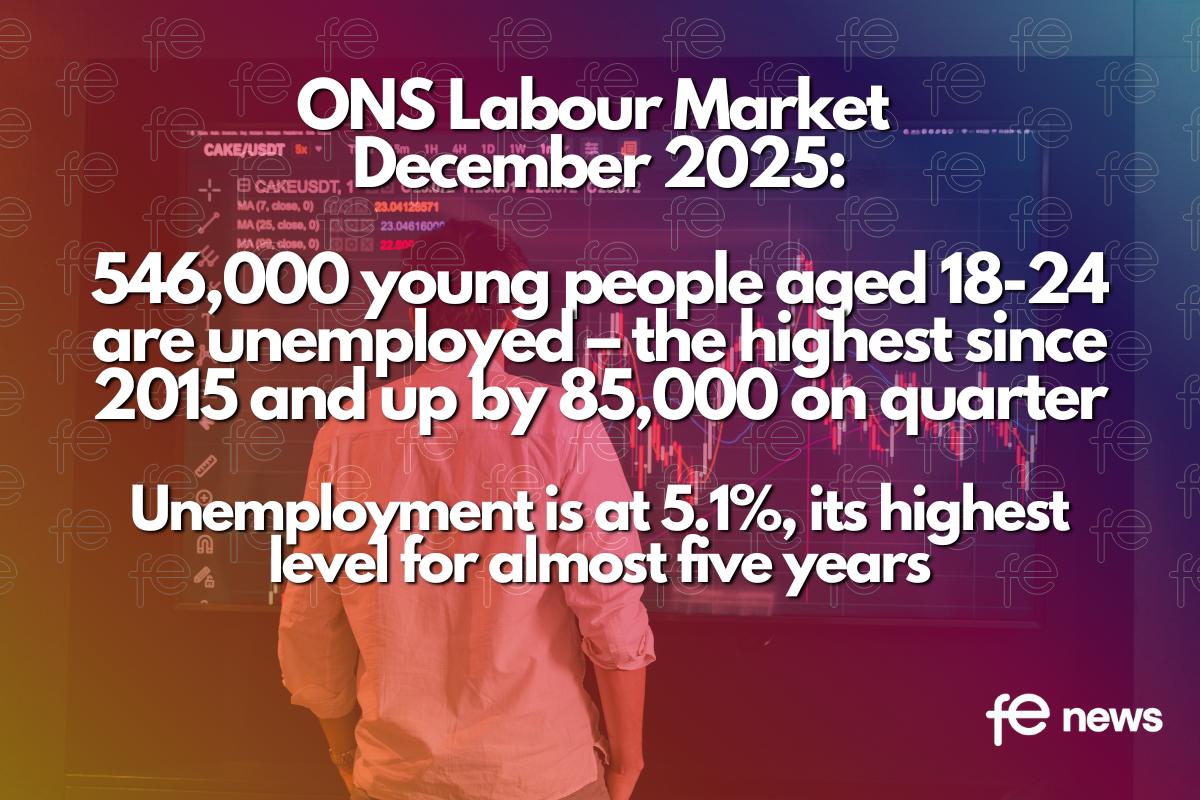Employment rate continues to fall, but vacancies are beginning to recover

UK labour market: December 2020
Early estimates for November 2020 suggest that there is a slight drop over the month in the number of payroll employees in the UK. Since February 2020, the number of payroll employees has fallen by 819,000; however, the larger falls were seen at the start of the coronavirus (COVID-19) pandemic.
Data from our Labour Force Survey (LFS) show a large increase in the unemployment rate while the employment rate continues to fall. The number of redundancies reached a record high in August to October 2020 although the weekly data show that while the level remains high there was a slight decrease in October.
Although decreasing over the year, total hours worked had a record increase from the low levels in the previous quarter, with the August to October period covering a time when a number of coronavirus (COVID-19) lockdown measures were eased. The number of people temporarily away from work has fallen since its peak in April and May 2020. The number of people away from work because of the pandemic and receiving no pay has also fallen and levelled off in recent months.
Vacancies have continued to recover in the latest period but are still below the levels seen before the impact of the coronavirus pandemic. Annual growth in employee pay continued to strengthen as more employees returned to work from furlough, but the estimated growth in average pay is also impacted by compositional effects of a fall in the number and proportion of lower-paid employee jobs.
 Chancellor of the Exchequer, Rishi Sunak, said:
Chancellor of the Exchequer, Rishi Sunak, said:
“We’ve been clear throughout this crisis that protecting lives and livelihoods is our number one priority. We’ve provided over £280 billion of support, including protecting over 9 million jobs with the furlough scheme and supporting millions of businesses to keep going with our loans, grants and tax cuts.
“But we know that, sadly, many people are already facing unemployment. That’s why our Plan for Jobs is also helping to create new jobs, including through our £2 billion Kickstart scheme and expanded apprenticeships and traineeships, to ensure nobody is left without hope or opportunity.”
 IES Director Tony Wilson said:
IES Director Tony Wilson said:
“Today’s jobs figures show that the labour market was starting to recover through September and October, but clearly remains far weaker than it was before this crisis began. While the record redundancy figures will likely take the headlines, looking beyond this the employment rate is now unchanged for the last three months and the rises in unemployment are being driven by falls in ‘economic inactivity’ as more of those who were choosing not to look for work during the crisis started to do so again. Perhaps most strikingly, in the last three months we’ve seen significant falls in employment for men – down by 150 thousand – while employment for women has risen slightly, driven by a rise of over 160 thousand in the number of full-time employees. This may well reflect people increasing hours in response to their partner losing their job or income, as we’ve seen in previous crises; or the fact that women are more likely to work in ‘key worker’ roles particularly in health and care.
“Looking ahead, today’s figures suggest that the labour market remained very fragile on the eve of the second lockdown with signs in the most recent vacancy figures that recruitment may have started to drop again in early November. So while today’s figures could have been worse, they are also unlikely to get much better any time soon. This reiterates the need to do all that we can to support a jobs recovery in the new year – in particular by ensuring that we can get a trade deal with the EU and can do more to boost jobs growth, hiring and support for the unemployed.”
 James Reed Chairman of REED:
James Reed Chairman of REED:
“With the latest ONS labour market statistics showing an increase in unemployment coinciding with the original end date of the furlough scheme, it’s clear to see the challenges the coronavirus pandemic poses for jobs across the UK.
“Having said many times over that the furlough scheme would end in October, the Chancellor’s decision to extend it has helped to keep many in employment and kept the ONS’s latest unemployment figures relatively low considering.
“The jobs market has been through one of its most turbulent periods in recent history, but in the face of adversity, the economy has shown great flexibility, dynamism and entrepreneurialism which have helped improve the economic outlook as we progress into 2021. As Brexit trade talks near a conclusion, the UK can draw on its experiences to make a success of our new relationship with the EU, regardless of whether or not we secure a deal from January 1st, 2021.
“I’m optimistic that we are moving towards a much better situation for jobs and, with the vaccine now being rolled out, we are a few months away from the economy fully opening up and a thriving jobs market once again.
“Looking at REED’s own jobs data from November, we saw the highest number of new jobs added to reed.co.uk since back in February. Every region from the UK apart from Scotland is seeing month on month increases despite the nationwide lockdown. If you are looking for work as we head into the new year, I urge you to be as open and flexible to any opportunities which may be available to you.”
 Paul Naha-Biswas, CEO and Founder at recruitment tech platform Sixley, said:
Paul Naha-Biswas, CEO and Founder at recruitment tech platform Sixley, said:
“Today’s ONS unemployment statistics bring us back down to earth after the giddy heights of ‘V-day’ last week. And, while the end of the pandemic may be in sight, these figures serve as a further reminder that the economic emergency is still underway.
“Yet, as we look to 2021, there are plenty of reasons to be optimistic about the future. The economic impact of the second lockdown was far smaller than the last, and job opportunities are beginning to emerge across the country, which is unsurprising given the crop of experienced, talented candidates available.
“With more jobs available, we should all look out for relevant opportunities for friends or family and share these across our network. Anyone in two minds about doing this should remember that recommending contacts for roles can help them stand out in a crowded job landscape and reduce the investment of time and money for a business.
“As the country begins its long economic recovery from COVID-19, we should focus our attention on the labour market: working together and helping one another find work to alleviate the stresses and financial challenges of unemployment.”
 Kirstie Donnelly MBE, CEO of City & Guilds Group commented:
Kirstie Donnelly MBE, CEO of City & Guilds Group commented:
“The latest unemployment data signals a worrying threat for the long-term health of the UK economy and jobs. With the unemployment rate rising to 4.9%, and redundancies surging to a record high of 370,000, worries over job security will mean a far from merry Christmas this year and more so a bleak outlook into the New year too.
“These figures are just the tip of the iceberg of challenges that await in 2021 – if we continue along the current trajectory, we will fail to shift the dial on this looming jobs crisis. If we are to turn the tide, we need to think completely differently about the support needed to help people who are at risk finding themselves jobless. This is not about reinventing the wheel, but allowing for the development of grassroots solutions, in regions across the country, to match skills to jobs and supply to demand in local economies.
“This begins with helping people to recognise and leverage valuable transferable skills sets – for all of those that have lost their jobs due to Covid. The funding City & Guilds Group recently secured from NESTA will do exactly that – helping those displaced from their careers by the pandemic to be redeployed into new jobs within sectors which are experiencing growth.
“As we move into the new year, it is more crucial than ever to change tack and act now, if we are to avoid a whole generation of people being left behind.”
 Stephen Evans, chief executive of Learning and Work Institute, said:
Stephen Evans, chief executive of Learning and Work Institute, said:
“The sharp rise in redundancies is likely to be partially due to the anticipated end of the furlough scheme before it was ultimately extended. Overall, unemployment has risen sharply this year, although measures like the furlough scheme have limited the damage.
“The rollout of a vaccine gives hope for 2021. But the prospect of tighter restrictions early in the year in response to any Christmas virus surge suggests further trouble ahead. The likelihood of either no deal or a relatively thin trade deal with the EU is also likely to lead to an increase in unemployment while our analysis shows a sharp rise in long-term unemployment is already baked in for 2021.
“All of that means that the Government is likely to need to go further and faster. The Restart programme is due to go live in the summer, too late for the likely surge in numbers long-term unemployed in the spring. We urgently need more help for people to find work and employers to create jobs.”
 Samantha Windett, Director of Policy at Impetus and Co-Chair of the Youth Employment Group said:
Samantha Windett, Director of Policy at Impetus and Co-Chair of the Youth Employment Group said:
“With redundancies in the three months to October reaching a new high of 370,000, young people continue to bear the brunt of the economic fallout of the coronavirus pandemic.
“Over 60 per cent of the total fall in employment in the last quarter was amongst 16-24 year olds. Already 2.5 times more likely to work in sectors worst impacted by lockdowns, the economic effect on young people will be exacerbated by the tier 3 restrictions affecting large parts of the country.
“Lack of government support during this time means those not in full-time education or employment has risen above 1 million, back to lockdown levels.
It will be months before the benefits of the vaccine rollout are felt, restrictions are lifted, confidence is restored and the jobs market is rekindled. We know that any period out of work can have a scarring effect on young people’s long-term job prospects and, as we move into a very difficult new year, we need to deliver on the Prime Minister’s Youth Opportunity Guarantee so more young people aren’t let down.”
 Ronel Lehmann, Founder and Chief Executive of Finito, The Employability Experts said:
Ronel Lehmann, Founder and Chief Executive of Finito, The Employability Experts said:
“For many years unemployment was at its lowest for decades. During this time of exceptional employment and opportunity, there were detractors who were mean spirited and could not bring themselves to recognise these achievements. Now that the pandemic has turned things full circle, I suspect the same people will bleat on about the Government not doing enough to combat rising unemployment.
“My own view is that whatever the short term pain which all of us have suffered while we waited for a vaccine, this Country will bounce back stronger and more resilient for future challenges. Ask any young person today, I find them to be full of hope energy and desire to make a success of their lives. No statistics from the ONS Labour market will stop them in their tracks. We all have a duty to help them”
Estimates of employment, unemployment, economic inactivity and other employment-related statistics for the UK.
Documents
UK labour market: December 2020
Labour market in the regions of the UK: December 2020
Official statistics are produced impartially and free from political influence.











Responses